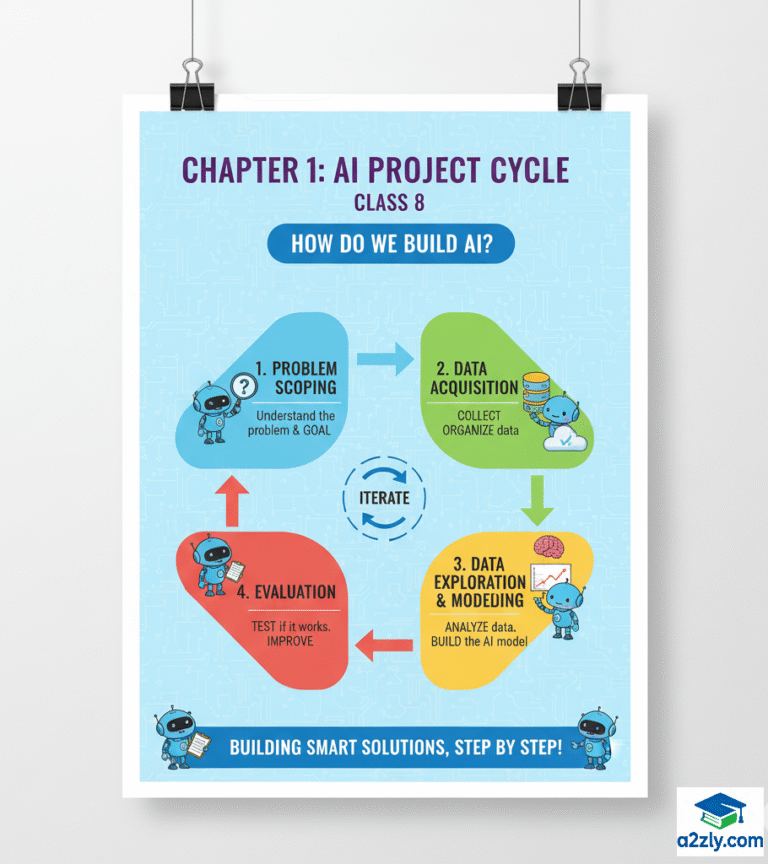1.1 Introduction to AI Project Cycle
Artificial Intelligence (AI) aims to build systems that can think, learn, and make decisions like humans.
But how do we actually develop an AI solution?
To make this process structured and efficient, AI experts follow a step-by-step process called the AI Project Cycle.
It is similar to how we plan a school project — from identifying the problem, gathering information, designing the solution, testing it, and then presenting it.
💡 Definition:
The AI Project Cycle is a systematic process that guides the development of an AI solution — from understanding the problem to deploying the final model.
🔄 Why AI Project Cycle is Important
| Purpose | Description |
|---|---|
| Structure | It organizes AI project development in clear steps. |
| Accuracy | Ensures that the problem is correctly defined and solved. |
| Efficiency | Saves time and resources. |
| Evaluation | Helps in measuring the performance of AI models. |
🧠 Analogy Example:
Think of it like preparing for your science exhibition project:
- Decide your topic → Problem Scoping
- Collect information → Data Acquisition
- Analyze what you found → Data Exploration
- Build your model/project → Modelling
- Test your project → Evaluation
- Present it in the exhibition → Deployment
🗺️ Mind Map: Introduction to AI Project Cycle
AI Project Cycle
|
---------------------
| | |
Problem Data Modelling
Scoping Handling |
| | |
| Exploration Evaluation
|________________________|
|
Deployment
1.2 AI Project Cycle — A Brief Discussion
The AI Project Cycle usually consists of 5 major stages, and sometimes a 6th stage (Deployment) is added.
| Stage | Name | Purpose |
|---|---|---|
| 1 | Problem Scoping | Understanding and defining the problem clearly. |
| 2 | Data Acquisition | Collecting relevant data to solve the problem. |
| 3 | Data Exploration | Analysing and understanding data patterns. |
| 4 | Modelling | Building and training AI models using data. |
| 5 | Evaluation | Testing model accuracy and performance. |
| 6 | Deployment | (Optional) Making the model available for use. |
1.3 AI Project Cycle — A Detailed Approach
Let’s study each stage in detail 👇
1.3.1 Understanding Problem Scoping
💡 Definition:
Problem Scoping means clearly identifying what problem you want your AI system to solve.
📋 Steps in Problem Scoping:
| Step | Description | Example |
|---|---|---|
| 1 | Identify the Problem | Traffic jams in the city. |
| 2 | Understand the Need | People face delays and pollution. |
| 3 | Define the Goal | Predict traffic and suggest alternate routes. |
| 4 | Set the Success Criteria | Accuracy of traffic prediction model. |
🧠 Mind Map: Problem Scoping
Problem Scoping
|
|-- Identify Problem
|-- Understand Need
|-- Define Goal
|-- Set Success Criteria
|-- Identify Stakeholders
🧩 Stakeholders:
People or groups who are affected by or interested in the project (e.g., drivers, police, government).
1.3.2 Data Acquisition
💡 Definition:
The process of collecting relevant and accurate data that helps the AI system learn.
📦 Sources of Data:
| Source Type | Example |
|---|---|
| Primary Data | Surveys, sensors, cameras, experiments |
| Secondary Data | Websites, databases, research papers |
⚙️ Data Collection Tools:
- Online forms and surveys
- Web scraping tools
- IoT sensors
- Open-source datasets (like Kaggle, UCI ML Repository)
⚠️ Important:
Data must be reliable, relevant, and unbiased.
Bad data = Bad AI model.
1.3.3 Data Exploration
💡 Definition:
Data Exploration involves analyzing and visualizing data to find patterns, errors, or relationships.
📊 Activities in Data Exploration:
| Step | Description |
|---|---|
| Data Cleaning | Removing missing or incorrect values. |
| Data Visualization | Using graphs, charts to understand data trends. |
| Feature Identification | Finding which variables affect the outcome. |
🧠 Example:
If you’re building an AI to predict student grades,
you might explore data like attendance, test scores, and homework completion.
📈 Common Tools:
- Python (Pandas, Matplotlib)
- Excel
- Google Sheets
- Tableau
1.3.4 Modelling
💡 Definition:
Modelling is the stage where you train the AI model using data to make predictions or decisions.
⚙️ Steps in Modelling:
| Step | Description |
|---|---|
| Data Splitting | Divide data into training and testing sets. |
| Model Selection | Choose algorithm (e.g., Decision Tree, Neural Network). |
| Model Training | Feed data to model to learn patterns. |
| Model Testing | Check how well it performs on new data. |
🧠 Example:
If you feed your AI model data of 1000 students’ grades,
it learns from 800 (training data) and predicts for 200 (testing data).
💬 Types of Models:
| Type | Example | Purpose |
|---|---|---|
| Classification | Spam or Not Spam | Categorical prediction |
| Regression | House Price Prediction | Continuous value prediction |
1.3.5 Evaluation
💡 Definition:
Evaluation means testing and measuring the performance of the AI model.
📏 Common Evaluation Metrics:
| Metric | Description |
|---|---|
| Accuracy | How often the model gives the right result. |
| Precision | Correctness of positive predictions. |
| Recall | Ability to find all positive cases. |
| F1 Score | Balance between precision and recall. |
🧠 Example:
If your traffic prediction model correctly predicts 90 out of 100 traffic jams,
its accuracy = 90%.
⚠️ Note:
If performance is poor → go back, improve data or model.
1.3.6 Deployment — The 6th Stage of AI Project Cycle
💡 Definition:
Deployment means putting the AI model into real-world use so people can access its results.
🧰 Deployment Examples:
| AI System | Deployment Example |
|---|---|
| Chatbot | Available on a website for customer queries |
| Face Recognition | Used in security systems |
| Weather Prediction | Shown in mobile apps or websites |
🧩 Post-Deployment Activities:
- Monitoring performance
- Collecting feedback
- Updating the model with new data
🧭 Complete Mind Map: AI Project Cycle
AI PROJECT CYCLE
|
------------------------------------------------
| | | | | |
Problem Data Data Modelling Evaluation Deployment
Scoping Acquisition Exploration
| | | | | |
Identify Collect Analyze Train Test Release
Problem Data Patterns Model Results Model
📘 Summary Table: AI Project Cycle
| Stage | Key Activity | Output |
|---|---|---|
| Problem Scoping | Define the problem | Problem Statement |
| Data Acquisition | Gather data | Dataset |
| Data Exploration | Analyze and visualize | Insights & Features |
| Modelling | Train the model | Trained Model |
| Evaluation | Measure performance | Accuracy Metrics |
| Deployment | Use in real life | Working AI System |
🧩 Real-Life Example:
AI Project — Predicting Crop Yield
| Stage | Description |
|---|---|
| Problem Scoping | Farmers face uncertainty about crop yield. |
| Data Acquisition | Collect soil data, rainfall, temperature. |
| Data Exploration | Analyze data trends and outliers. |
| Modelling | Train AI model to predict yield. |
| Evaluation | Test with recent data, check accuracy. |
| Deployment | Launch mobile app for farmers. |
✅ Key Takeaways
- The AI Project Cycle gives a systematic roadmap to build AI solutions.
- It includes Problem Scoping → Data Acquisition → Data Exploration → Modelling → Evaluation → Deployment.
- Each stage is interdependent — if one fails, others are affected.
- Data quality and problem clarity are the foundation of a good AI project.

